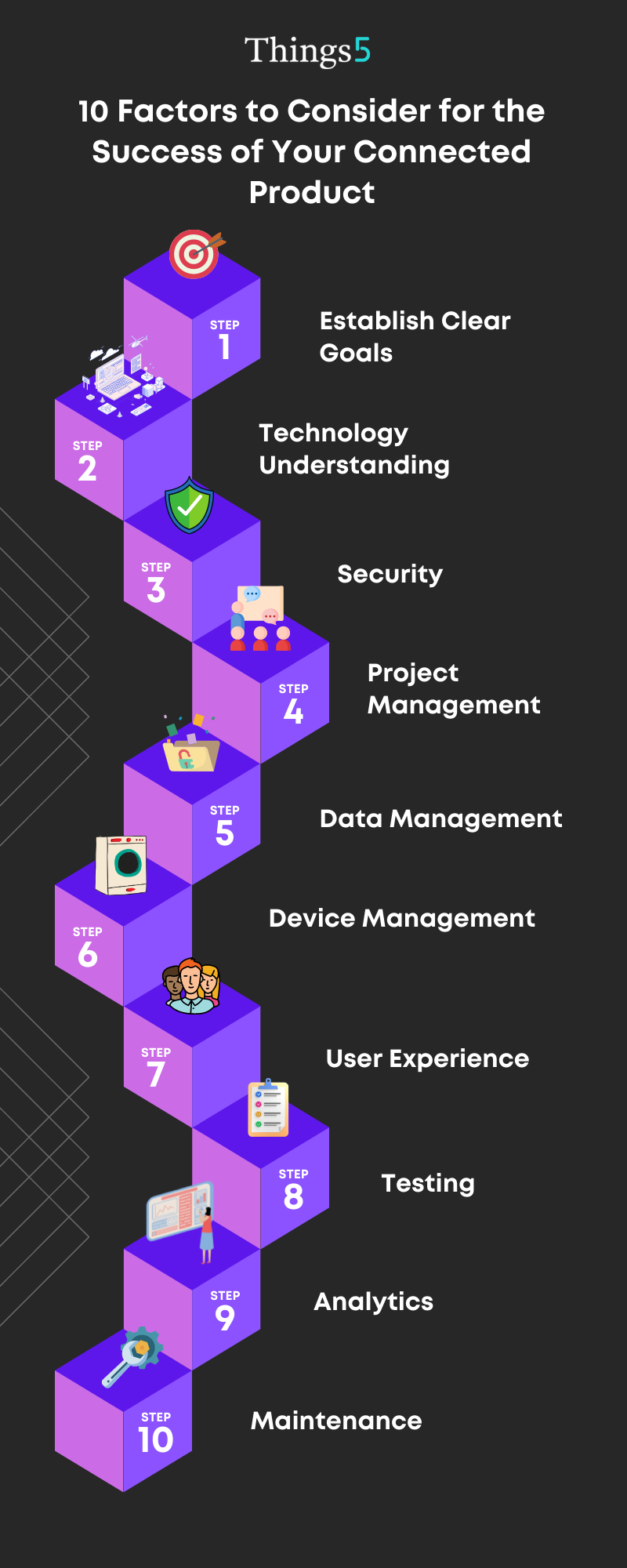10 Factors to Consider for the Success of Your Connected Product

Daniele Delle Case
Published: March 23, 2022
The Internet of Things (IoT) is transforming the way products are designed, developed, and delivered. For connected product providers, the benefits that IoT data can provide are immense. From enhancing the customer experience to more targeted marketing campaigns, the impact of IoT data is far-reaching. For any IoT project, there are several key aspects to consider to ensure success. Defining clear goals, understanding the technology, and developing a comprehensive security strategy are all essential. Additionally, project management, data management, device management, user experience, testing, analytics, and maintenance must all be taken into consideration. By understanding the project requirements and taking the necessary measures to ensure success, connected product providers can maximize their IoT data and reap the rewards.

Benefits of IoT Data for Connected Product Vendors
The benefits of IoT data for connected product vendors can be immense. By leveraging the data generated by connected products, providers can gain valuable insights into customer behavior and preferences. This can help them better customize their products and services to meet customer needs, resulting in improved customer experience and increased customer satisfaction. Additionally, IoT data can be used to create more targeted marketing campaigns and promotions. This can help providers differentiate their products and services in the market, leading to improved market penetration and increased revenues. With the right strategies in place, connected product providers can leverage the power of IoT data to drive their businesses forward.
Experience the IoT platform that will make you fall in love with your data. Try Things5.
Aspects to consider for your IoT Project.
When undertaking an IoT project, it is essential to consider several key aspects to ensure its success. Setting clear goals and understanding the technology are the first steps of any successful IoT project. Having a clear understanding of the project goals and objectives will allow for proper planning, development, and implementation of the project. Additionally, it is important to have an in-depth understanding of the underlying technology components and the skills needed to use them. Furthermore, a comprehensive security strategy must be developed to protect data and devices. Additionally, project management, data management, device management, user experience, testing, analytics, and maintenance must be taken into consideration. By understanding the project requirements and taking the necessary measures to ensure its success, connected product providers can best leverage their IoT data and reap the benefits.
1. Establish Clear Goals
Establishing clear goals is an essential step for the success of any IoT project. With a clear understanding of the project’s goals and objectives, it is possible to plan, develop, and implement the project correctly. It is important to identify the specific needs of the project and create a roadmap that outlines the steps to achieve those goals. Additionally, it is important to consider the project timeline and set deadlines to ensure the project is completed in a timely manner. Establishing clear goals will help ensure the success of the project, allowing connected product providers to make the most of their IoT data.
2. Understand the Technology
Understanding the technology is critical for the success of any IoT project. It is important to have a deep understanding of the underlying components of the technology and the skills needed to use them. This includes knowing which hardware components and software platforms are required for the project, as well as being knowledgeable in the various communication protocols and standards. Additionally, it is important to have a basic understanding of the data that will be collected and stored and how it will be used. With a deep understanding of the technology, connected product providers can ensure their IoT projects are successful.
3. Security
Security is an important aspect to consider when developing any IoT project. To ensure that data and devices remain secure, it is necessary to develop a comprehensive security strategy. This should include authentication and access control measures, such as multi-factor authentication and encryption. Additionally, it is important to consider how data will be stored and transmitted and make sure all data is stored securely in a secure environment. Furthermore, it is important to consider the potential risks and vulnerabilities associated with the project and take the necessary measures to mitigate them. By taking the necessary security measures, connected product providers can ensure their data and devices remain secure and their projects are successful.
4. Project Management
Project management is an important aspect of any successful Internet of Things (IoT) project. It is important to develop a comprehensive project management plan that includes activities, timeline, and milestones to ensure the project is completed on time and within budget. This plan should include a detailed list of activities to be performed and the resources and personnel needed to complete them. Additionally, it should include a timeline of when the activities should be completed, as well as any milestones, such as product launch or customer feedback. With a well-defined project management plan, connected product providers can ensure their projects are completed on time and within budget, allowing them to make the most of their IoT data.
5. Data Management
Data management is an important aspect of any successful Internet of Things (IoT) project. Data management involves determining how data will be collected, stored, and used. It is important to identify the types of data that will be collected and ensure they are stored in a secure environment. Additionally, it is important to develop a system for storing and retrieving data, such as a database or cloud memory. Furthermore, it is important to consider how the data will be used, such as for analytics or customer feedback. By understanding the data management requirements, connected product providers can ensure their data is collected, stored, and used securely, allowing them to make the most of their IoT data.
6. Device Management
Device management is an essential aspect of any successful IoT project. It involves creating a system to manage devices and their associated data. This includes determining how devices are connected and exchanging information between them, and how they are securely authenticated and authorized for access to data. Additionally, it is important to develop a system to manage the firmware and software installed on devices. Furthermore, it is important to consider how devices will be monitored and maintained, and how data will be backed up and stored. By creating a comprehensive device management system, connected product providers can ensure that their devices remain secure and their data remains accurate and accessible.
7. User Experience
User experience is an important aspect of any successful IoT project. Developing a user-friendly interface is essential to ensure that the system is intuitive and easy to use. This involves considering the user’s needs and preferences, such as the type of device they are using and the type of data they will interact with. Additionally, it is important to consider the visual design of the interface, as well as the navigation and interactivity. Finally, it is important to develop a system to provide feedback to users, such as notifications or alerts. By considering user experience in system design, connected product providers can ensure that their users have a positive experience, allowing them to make the most of their IoT data.
8. Testing
Testing is an essential aspect of any successful IoT project. It is important to ensure that the system is thoroughly tested prior to launch to ensure that all components function as expected. This includes testing the device’s hardware and software, as well as the communication protocols and data processing systems. Additionally, it is important to test the user interface to ensure that it is easy to use and intuitive. Furthermore, it is important to perform a security test of the system to ensure that data is stored and transmitted securely. By testing all aspects of the system, connected product providers can ensure that their projects are successful, allowing them to make the most of their IoT data.
9. Analytics
Analytics are an important aspect of any successful IoT project. It is essential to establish a system to collect and analyze system data. This involves identifying the important data to collect and store, as well as the mode of analysis. Additionally, it is important to consider how the data will be visualized, such as through graphs or dashboards. Furthermore, it is important to consider how analytics can be used to provide insights into customer behaviors and preferences, allowing connected product providers to make more informed decisions. By establishing a comprehensive analytics system, connected product providers can ensure that their projects are successful, allowing them to make the most of their IoT data.
10. Maintenance
Maintenance is a fundamental aspect of any successful IoT project. It is important to establish a robust maintenance plan to ensure that the system continues to function as expected. This involves regularly monitoring the system for any errors or issues, as well as ensuring that the system is up to date with the latest security patches and updates. Additionally, it is important to establish a system to provide technical support and resolve any issues that may arise. Furthermore, it is important to consider how the system can be scaled up or down based on customer demand, allowing connected product providers to adjust to an increase or decrease in usage. By establishing a comprehensive maintenance plan, connected product providers can ensure that their projects are successful, allowing them to make the most of their IoT data.
3. Conclusions
The Internet of Things (IoT) provides connected product providers with a wealth of data and information. To make the most of this data, several aspects must be considered. Setting clear objectives, understanding the technology, and developing a comprehensive security strategy are essential. Additionally, project management, data management, device management, user experience, testing, analytics, and maintenance must be taken into account. By understanding the project requirements and taking the necessary measures to ensure its success, connected product providers can make the most of their IoT data and reap all the benefits.
To manage all these aspects effectively, platforms like
Things5 allow you to set up the entire infrastructure for your connected product, reducing the effort required and simplifying the extraction of value generated from the data generated by your devices. Book your demo. Experience the superpowers of the Internet of Things.
Experience the IoT platform that will make you fall in love with your data. Try Things5.

USEFUL LINKS
SUBSCRIBE TO OUR NEWSLETTER
You need a helping hand with your project?
We will get back to you as soon as possible
Please try again later
All Rights Reserved | Visup Srl | VAT: IT09299620964

